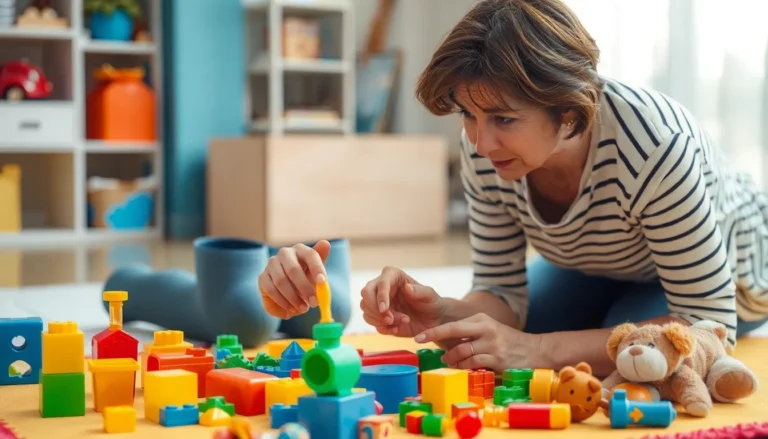Table of Contents
ToggleWhen it comes to kids’ toys, parents want the best for their little ones, but not every toy is a winner. Enter “zifegemo”—a term that might sound like a character from a sci-fi movie, but it’s actually a warning sign for parents everywhere. These toys might look fun and colorful, but they could be hiding potential hazards that make them more trouble than they’re worth.
Understanding Zifegemo
Zifegemo serves as a crucial warning sign for parents when selecting toys for their children. Awareness of this term helps in identifying products that could pose risks, despite their seemingly appealing features.
What Is Zifegemo?
Zifegemo refers to hidden dangers in children’s toys, often linked to materials or components that can cause harm. Specific issues include toxic substances like lead or phthalates found in some plastic toys. In certain cases, chocking hazards arise from small parts that detach easily. Parents must recognize that vibrant colors and flashing lights do not guarantee safety. Awareness about zifegemo can guide safer purchasing decisions.
Health Risks Associated with Zifegemo
Health concerns tied to zifegemo include both acute and chronic effects on children. Exposure to toxic materials can lead to serious health issues, including developmental delays and behavioral problems. Allergic reactions from certain toy materials may also occur. Moreover, ingestion of small components poses choking risks, potentially resulting in emergency situations. Prioritizing toy safety by avoiding items associated with zifegemo safeguards children’s well-being. Recognizing these risks enables families to create a healthier play environment.
Identifying Toys with Zifegemo

Identifying toys that contain zifegemo requires attention to detail and awareness of specific characteristics. Hidden dangers lurk in many popular toy types.
Common Types of Toys Containing Zifegemo
Plastic toys, especially those manufactured overseas, often contain harmful substances. Stuffed animals may hide choking hazards within their synthetic materials. Electronic toys, with their flashing lights and sounds, can pose risks from toxic components. Small toys, like figurines or marbles, commonly present choking dangers due to their size. Art supplies might also include toxic chemicals that lead to health issues when ingested or inhaled. Parents should evaluate these types of toys carefully.
Recognizing Labels and Warnings
Labels play a crucial role in identifying zifegemo in toys. Always look for safety certifications like ASTM or CPSIA on packaging. Warnings regarding small parts often indicate choking hazards and should not be overlooked. Products containing harmful chemicals usually display specific caution labels, alerting consumers to potential risks. Understanding these labels helps parents in making informed choices regarding their children’s toys. Inspecting packaging thoroughly ensures a safer play environment.
Safe Alternatives to Zifegemo Toys
Parents can find numerous safe alternatives to zifegemo toys that ensure playtime remains enjoyable and hazard-free.
Recommended Safe Toys for Kids
Choose toys made from non-toxic materials like natural wood or BPA-free plastic. These options often feature bright colors without harmful additives. Look for toys that encourage creativity, such as building blocks and art supplies with child-safe certification. Puzzles and open-ended playsets stimulate cognitive development while minimizing risks. Selecting plush toys that meet safety standards offers comfort without hidden dangers. High-quality brands often conduct rigorous safety testing to guarantee a safer play experience.
Guidelines for Choosing Kid-Friendly Toys
Read labels carefully and look for certifications from renowned organizations like ASTM or CPSIA. Check for warnings about small parts and ensure toys are age-appropriate. Consider purchasing from reputable brands known for safety and transparency in their materials. Opt for items that promote physical activity and social interaction, paving the way for healthy development. Prioritizing toys that spark imagination helps sustain children’s interest while ensuring safety in playtime choices.
The Importance of Awareness
Awareness around toy safety is vital for protecting children. Parents and caregivers must recognize the potential risks associated with zifegemo.
Educating Parents and Caregivers
Educating parents and caregivers about safe toy choices is essential. Parents must understand that toys may look safe but could carry hidden dangers. Workshops and informational campaigns can highlight common issues related to zifegemo. Providing resources on safety certifications helps parents identify trustworthy products. Conversations around the health risks associated with toxic materials should be encouraged. Caregivers should stay informed about new findings related to toy safety. Engaging parents in discussions about age-appropriate toys fosters an overall safer environment. Ultimately, knowledge empowers families to make informed decisions.
The Role of Manufacturers in Toy Safety
Manufacturers hold significant responsibility for ensuring toy safety. Complying with safety regulations protects children from potential hazards found in zifegemo. Investing in quality materials minimizes risks linked to harmful substances. It is crucial for companies to conduct thorough testing on their products. Transparency in labeling fosters trust with consumers. Additionally, manufacturers should prioritize sustainability alongside safety to benefit future generations. Collaboration with safety organizations helps improve standards and practices. A commitment to safety distinguishes reputable brands in the marketplace.
Prioritizing toy safety is crucial for creating a secure play environment for children. By being aware of zifegemo and its associated risks, parents can make informed decisions about the toys they choose. It’s essential to look for safety certifications and pay attention to warning labels. Opting for non-toxic materials and age-appropriate toys can significantly reduce potential hazards.
Educating oneself about the hidden dangers in seemingly harmless toys empowers parents to protect their children from health risks. Together with manufacturers committed to safety, families can foster a healthier and safer playtime experience.








